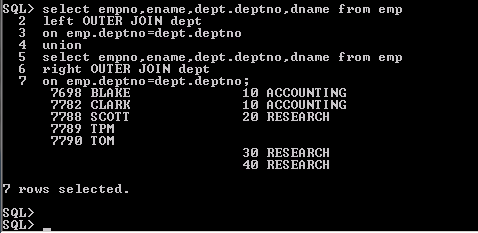
This tutorial explains FULL OUTER JOIN and uses in Oracle. The FULL OUTER JOIN keyword returns all records when there is a match in left (table1) or right (table2) table records. Note: FULL OUTER JOIN can potentially return very large result-sets! Tip: FULL OUTER JOIN and FULL JOIN are the same.
For each row in the Ttable, the full outer join compares it with every row in the Ttable. If rows from both tables meet the join _condition, the full outer join includes columns of both rows in the result set. We say that the row in Ttable matches with the row in the Ttable in this case.
This Oracle tutorial explains how to use JOINS (inner and outer) in Oracle with syntax, visual illustrations, and examples. Oracle JOINS are used to retrieve data from multiple tables. Snippet Name: FULL JOIN example and syntax Description: The FULL JOIN keyword return rows when there is a match in one of the tables. A full outer join combines the of both left and right outer joins.

Multiple FULL OUTER JOIN on multiple tables. SQL FULL JOIN Examples ProbleMatch all customers and suppliers by country SELECT C. Country AS CustomerCountry, S. CompanyName FROM Customer C FULL JOIN Supplier S ON C. Złączenia typu JOIN ZŁĄCZENIA TYPU JOIN JOIN ON. Wyświetla niedopasowane elementy z obu tabel. A join is a query that combines rows from two or more tables, views, or materialized views.
Oracle Database performs a join whenever multiple tables appear in the FROM clause of the query. The select list of the query can select any columns from any of these tables. The joined table will contain all records from both tables, and fill in NULLs for missing matches on either side. What is Full Outer Join in SQL?
In SQL the FULL OUTER JOIN combines the of both left and right outer joins and returns all (matched or unmatched) rows from the tables on both sides of the join clause. JOINS IN ORACLE -different joins in oracle with examples 1. This will display the all matching records and the non-matching records from both tables. Learn how to use left and right joins using the plus sign in an Oracle database. Oracle allows queries to be generated that JOIN rows from two or more tables. The basic syntax of a FULL JOIN is as follows −. Ask Question Asked years, months ago.
SELECT month, columnFROM table1) A FULL OUTER JOIN (SELECT month, columnFROM table2) B on A. In this tutorial you will learn how to retrieve data from two tables using SQL full join. A FULL JOIN returns all the rows from the joined tables, whether they are matched or not i. Better Alternatives to a FULL OUTER JOIN. As many of you know, I strongly recommend that you avoid using RIGHT OUTER JOINs, since they make your SQL code less readable and are easily rewritten as LEFT OUTER JOINs. In addition, I have yet to find a situation where a FULL OUTER JOIN makes. In this example, there is a NULL value for the fields xxtable.
Note that all of the records of the right table in a RIGHT OUTER JOIN get displaye regardless of whether or not they match rows in the left table. Summary: in this tutorial, you will learn how to use the Oracle LEFT JOIN clause to query data from multiple tables. Introduction to Oracle LEFT JOIN clause. Oracle joins with examples are given below to describe Oracle Joins using new syntax.
Which is very easy to understand and very good in SQL query readability. Because if query is larger and having too many tables with too many joins in old syntax it becomes complex to understand. LEFT, RIGHT, FULL OUTER JOIN).
Hi Tom, I know in oracle9i we have the cross join and full outer join.
Brak komentarzy:
Prześlij komentarz
Uwaga: tylko uczestnik tego bloga może przesyłać komentarze.